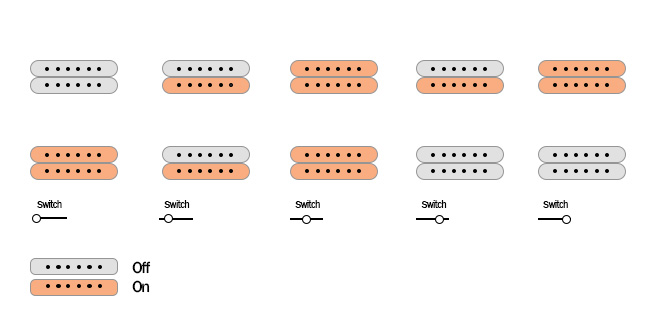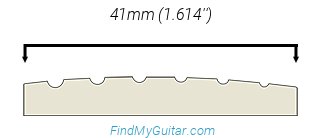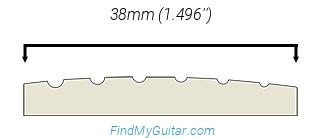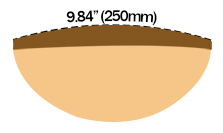Epiphone Rex Brown Thunderbird vs Yamaha TRBX304
Reasons to Get
Epiphone Rex Brown Thunderbird over Yamaha TRBX304
Reasons to Get
Yamaha TRBX304 over Epiphone Rex Brown Thunderbird
Other Key Differences
Epiphone Rex Brown Thunderbird vs Yamaha TRBX304
Shared Features
Epiphone Rex Brown Thunderbird vs Yamaha TRBX304
Common Strengths
- Expensive Wood
Common Weaknesses
- Pickup Alter Switch/Knob
- Weight Relief
- Retainer Bar
- High-Quality Frets
- Compound Radius Fretboard
- Luminescent Sidedots
- Strap Lock
- 21:1 Tuner Ratio
Price History Comparison
These are affiliate links. We may earn a fee if you purchase after clicking. These prices are prone to error. Make sure you're buying the right product after clicking on a link from our site. We are not liable if you buy the wrong product after following these links. As an Amazon Associate site we earn from qualifying purchases.
Which One is Better for Beginners?
Both meet 4 out of our 6 criteria items for beginner friendliness. This takes into account the type of frets, scale length, nut width, bridge type, fretboard radius, and neck profile to determine the easiest combination for new players. If you're looking for your first bass to learn how to play, you can't go wrong with either of them.
New Player Friendliness
Epiphone Rex Brown Thunderbird- Comfortable shape
- Tall frets
- Narrow nut
- Comfortable neck
- Comfortable fretboard
- Short scale
New Player Friendliness
Yamaha TRBX304- Comfortable shape
- Comfortable fretboard
- Tall frets
- Comfortable neck
- Narrow nut
- Short scale
Nevertheless, when it comes to choosing an instrument, you should pick the one more compatible with your personal style. Still, below we'll try you to give you our results as objectively as it's possible to help you decide.
Sound Quality Comparison
The wood used in an electric guitar or bass is not as important to determine the final tone. However, some people prefer specific wood types, so we'll take a look at those first. Then, we'll take a look at the electronics to determine the versatility and sound quality of each instrument.
Woods Used in Both

Mahogany is a fairly rare wood nowadays. It's used mostly for bodies due to its relatively lightweight. Gibson popularized it with their Les Paul guitars during their golden years, so this wood has a lot of good reputation behind it. The most expensive type comes from South America and it's still used by Gibson even today. Find out more about Mahogany.
Woods Used in the Epiphone Rex Brown Thunderbird

There are many types of Laurel, but East Indian is the most common for guitar building. Its color can vary from dark to light brown with black lines. Many people find its tonality similar to Rosewood, which favors the warmer frequencies. Find out more about Laurel.
Woods Used in the Yamaha TRBX304

Rosewood is an almost purple-looking wood that is used mainly for fretboards since it's heavy, rare, and expensive. It's sometimes used on acoustic guitar bodies to create stronger warm tones. Find out more about Rosewood.
Winner: Yamaha TRBX304.
Pickup Configuration
Both pickup configurations are HH. Double Humbucker (HH) is the choice for people who want a fuller, more round sound with tons of mids and lows. Humbuckers also get rid of the hum noise that plague single-coil pickups. They can work out for almost any genre going from Djent to even Jazz.
Pickups Quality
The Yamaha TRBX304 pickups from a more specialized brand than the Epiphone Rex Brown Thunderbird. Its pickups should give you a fuller, richer sound, although it all depends on what type of music you're going to play. We recommend these pickups for Heavy Metal and similar genres.
Both use Passive pickups. This is what's used for most music genres. They have a regular output and will serve you for both high-gain and clean tones. The alternative (Active pickups) offer a higher output that is mostly used for heavy music.
Preamp Circuit
A preamp in an electric bass functions as an electronic circuit that acts as an interface between the bass's pickups and the amplifier. Its main purpose is to amplify and customize the bass's initial signal before it reaches the amplifier, offering enhanced control over factors like tone, volume, and sound attributes. Preamps typically come equipped with tone adjustments, equalization options, and sometimes built-in effects, empowering bass players to fine-tune their sound to suit their personal preferences and the musical environment.
The Epiphone Rex Brown Thunderbird's preamp is Passive while the Yamaha TRBX304's is Active/Passive.
Passive: A bass with a passive preamp lacks an onboard electronic circuit for tone shaping and signal boosting. Instead, it relies solely on passive pickups and basic tone controls, typically consisting of volume and tone knobs. Passive preamps don't require an external power source like batteries, making them low-maintenance and dependable. While they offer a simpler and more straightforward tonal character, passive basses are appreciated for their warm and vintage sound, often favored in genres like classic rock, blues, and funk. They are an excellent choice for musicians who value the simplicity and timeless appeal of their instrument's tone without the need for active electronic components.
Active/Passive: This type of circuit combines both passive and active electronics in one instrument. This versatile setup allows the player to switch between passive and active modes, providing a wide range of tonal options. In passive mode, the bass relies on traditional passive pickups and tone controls for a warm and organic sound. In active mode, the onboard preamp circuit is engaged, offering enhanced EQ shaping capabilities and sometimes a signal boost. This flexibility caters to a broader spectrum of musical styles and playing preferences, as it allows the bassist to switch between the classic, vintage tone of passive operation and the more versatile and finely tuned active mode, all within the same instrument.
Winner: Yamaha TRBX304.
Versatility Comparison
Some instruments offer you more ways to explore your creativity than others. Below you'll find how both compare when it comes to versatility.
Switch Options
The Yamaha TRBX304 gives you 5 switch options while the Epiphone Rex Brown Thunderbird gives you 0. This means that the Yamaha TRBX304 gives you more options to find the right pickup combination for the type of sound you want to achieve
Neither of them come with some kind of coil split or pickup mod option. This makes both lacking in terms of versatility.
The Epiphone Rex Brown Thunderbird doesn't come with pickup switching options.

When evaluating versatility, we also take into consideration bridge and neck joint type, number of frets, switch options, amount of pickups and more.
Winner: Yamaha TRBX304.
Final Sound Quality Scores
Build Quality Comparison
When it comes to build quality, we like to take into account everything used to build the instrument. This includes materials, hardware and the quality control expected depending on the country where it was built. Let's see how the Epiphone Rex Brown Thunderbird compares to the Yamaha TRBX304.
Country of Origin
The manufacturing country can tell a lot about the build quality of an instrument. The Epiphone Rex Brown Thunderbird is built in China while the Yamaha TRBX304 is made in Indonesia.
China has a bad reputation when it comes to building quality. However, times have changed and now respectable brands use China's cheap labor to build good instruments for a lower price. Don't discount a guitar only because it was built in China, but also expect more quality from countries like Korea.
Indonesia is becoming the most popular country for guitar building because they can make good instruments for a low price. Some people think that they're 'the new China' when it comes to build quality. But the truth is that Indonesian guitars are more consistent, although Chinese quality has improved a lot in the last few years.
Winner: Yamaha TRBX304
Nut Material
If you want your bass to stay in tune and sound good, you need a well cut nut. Nut quality can be inconsistent even when comparing two copies of the same model. The best way to make sure you're nut will be well done is by getting a nut made by an expert company like TUSQ or Micarta.
The Epiphone Rex Brown Thunderbird has a Brass nut. Guitarists used to love brass nuts due to the bright tone and good sustain they help achieve. However, now they use Bone more often since it can also produce a bright tone and longer sustain, but it's also oily, which helps to keep the guitar in tune.
On the other hand, the Yamaha TRBX304 comes with a Plastic nut. This is a low-quality nut that you might want to consider upgrading soon. Bone and TUSQ nuts are the best for guitars with a fixed or simple tremolo bridge.
Winner: Epiphone Rex Brown Thunderbird.
Fret Material
Most fret wire is made of nickel silver. This material eventually wears down after a lot of use and most instruments end up needing a complete fret replacement. However, some expensive models come with stainless steel frets. This is what you should aim for if you can afford it.
Unfortunately, none of them come with stainless steel frets.
Winner: Tie.
Tuners
Both come with regular tuners. The Epiphone Rex Brown Thunderbird's are Gold Die Cast with Mini Clover Buttons while the Yamaha TRBX304's are Covered / Die-cast
Winner: Tie.
Neck Joint
Contrary to popular belief, the difference in sustain and tone that some neck joints give to a bass is simply unperceivable—if they're all well built. However, some of them do have advantages over the others.
The Epiphone Rex Brown Thunderbird has a Neck-Through neck joint. This neck is a lot more resistant and lets builders give the neck joint a more comfortable shape for soloing at the upper frets. The disadvantage is that they're more expensive and that if you damage your neck, you can't simply replace it like with bolt-on necks.
On the other hand, the Yamaha TRBX304 comes with Bolt-On neck joint. This neck is joined to the body by 4 bolts that you can simply unscrew. This allows you to replace the neck or take it off for travel. It's the most common and cheapest way to build a guitar.
Winner: Epiphone Rex Brown Thunderbird.
Here is the list of features that were considered when choosing the winner in the Features subcategory:
Epiphone Rex Brown Thunderbird
- Expensive Wood
- Neck-Through Build
- Cheap Fret Wire (NS)
- No Locking Tuners
- Made in China
- No High-Quality Nut
- No Top Brand Pickups
- No Push Knob or Extra Switch Option
- No Weight Relief
- No Luminescent Inlay
- No Active Preamp
- No Compound Radius Fretboard
- No 21:1 Tuner Ratio
- No Retainer Bar
- No Strap Lock
Yamaha TRBX304
- Expensive Wood
- Top Brand Pickups
- Active/Passive Preamp
- Cheap Fret Wire (NS)
- No Locking Tuners
- Made in Indonesia
- No High-Quality Nut
- No Neck-Through Build
- No Push Knob or Extra Switch Option
- No Weight Relief
- No Luminescent Inlay
- No Compound Radius Fretboard
- No 21:1 Tuner Ratio
- No Retainer Bar
- No Strap Lock
Final Build Quality Scores
Playability Comparison
Let's now compare their playability. Bear in mind that the instrument will feel different depending on your hand size and play style. That's why you should always test before buying. But if you can't or want a second opinion on it, we can still take a look at each of the important measurements of the instrument for you. This way, we can predict how easy a bass might be to play, or how different it will feel compared to the other.
Remember that, even though the difference might seem small, every inch counts when it comes to feeling of the instrument in your hands. Any variation can completely change how comfortable a bass feels in your hands.
Nut Width


The nut width will affect the separation between strings at the nut. In this comparison, the Epiphone Rex Brown Thunderbird has the wider nut with 41mm (1.614'') vs 38mm (1.496''). This is a 3mm (0.118'') difference
This means that it will be more difficult to do bar chords on the Epiphone Rex Brown Thunderbird, especially closer to the nut. However, it's also easier to play without muting strings accidently. This favors people with big hands.
Scale Length

The scale length is one of the things that influences playability the most. This is the distance between the nut and the bridge and will affect everything from low action allowance, difficulty to perform bends, fret separation, and even tone.
In this case, both have a scale length of 34".
This is a scale used for baritones and guitars with more than 6 strings. Since the scale is so long, the tension of the strings will be higher. This means that bending will require a lot more strength than with a shorter scale. However, it also allows you to use really low tunings without causing fret buzz and without needing to increase your string gauge too much.
Lastly, remember that you can also affect the tension of the strings by changing your string gauge. You can use a thicker gauge for more tension and a lighter one for less tension.
Neck Profile

No single neck shape is better than others. However, most people tend to prefer a thinner necks because it doesn't get in their way when playing fast and most hand sizes can adapt to it pretty well. However, some people still prefer thicker necks for a better grip, especially if they have big hands.
Both the Epiphone Rex Brown Thunderbird and the Yamaha TRBX304 have a C-shaped neck. This is what you'll find in most modern guitars. Most people feel like the thickness of a C neck is simply the less intrusive one for playing fast, while at the same time allowing you to grab the neck easily for resting if you want to.
Fretboard Radius


Most bass fretboards are not flat; they usually have a curve or arc across their width. A curved fretboard will make it easier to perform chords without muting strings, while a flatter one will make it easier to play single notes, which is good for bending and soloing in general. The best fretboards have a compound radius that varies across the fingerboard, but they're not common since they take a lot more work to build.
In this case, the Yamaha TRBX304's fingerboard radius is smaller, which means it's more curved than the Epiphone Rex Brown Thunderbird's. This extra arc will make playing chords easier in this model. You won't be as likely to mute the strings, especially if you have big hands. However, playing single notes and bending will be easier on the Epiphone Rex Brown Thunderbird.
Hand Size Comfortability
Everyone has a different hand size, and that's why it's recommended to try a bass before buying, even if others tell you that it's comfortable to play. However, we can know whether a bass favors small or large hands just by knowing its exact measurements.
And after taking into account the scale length, nut width, neck profile and fretboard radius, we can conclude that the Yamaha TRBX304 favors large hands more than the Epiphone Rex Brown Thunderbird.
Epiphone Rex Brown Thunderbird:
Yamaha TRBX304:
Fret Size


The Epiphone Rex Brown Thunderbird has Medium Jumbo frets, which should be taller than the Yamaha TRBX304's Medium frets.
Some people prefer taller frets because they result in more sustain since the strings get pressed cleanly without interference from the fretboard. However, if they're too tall—like Jumbo frets—, you might change the pitch of the strings accidentally if you press too hard because you won't be touching the fretboard with your fingers. This is also why some guitarists with a heavy grip prefer smaller frets. They like to feel the fingerboard to avoid pressing down too hard and getting out of pitch.















